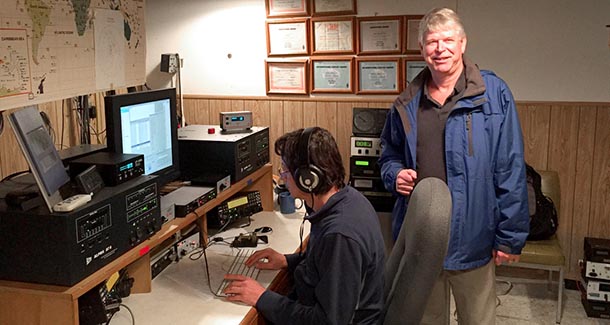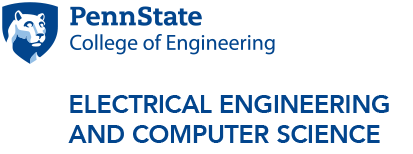
James Breakall with his friend Alex Avramov, a Penn State meteorology graduate, who helped Breakall build his own ham radio station.
Electrical engineer pitches in after hurricane hits Puerto Rico
12/4/2017
The day after Hurricane Maria ravaged Puerto Rico, Angel Vazquez, head of telescope operations at the Arecibo Observatory—one of the most important radio telescopes in the world—ventured out of his home to assess the damage at work. Driving his SUV behind a backhoe through flooded towns, maneuvering past downed trees and power lines, the normally 20-minute commute took Vazquez two hours.
Approaching the observatory, Vazquez said, was a beautiful thing. He had been worried that it would have been completely destroyed but the telescope was there—it was damaged but mostly still intact. A 96-foot long antenna that helps receive and transmit signals broke off and fell onto the dish 500 feet below. And more importantly, the staff that sheltered there through the storm were all safe.
But what made things very complicated was a lack of power. Reaching out to the world to let family and friends know they were safe after the Category 4 storm and that they were in desperate need for some amenities would prove difficult. But thankfully, Vazquez had a good friend at Penn State.
Electrical engineering professor James Breakall, who first visited the observatory on the island in 1974 as an undergraduate student, has known Vazquez for 40 years. The two built their friendship as Breakall, whose research is in antennas, radio engineering and electromagnetics, continued to do research at observatory often, and built a second home and his own antenna on the island.
“I got word from another ham radio person that he’d heard from Angel, who wanted to schedule a time to talk,” explained Breakall.
Recently awarded the Radio Club of America’s (RCA) Sarnoff Citation for his significant contributions to the advancement of electronic communications, Breakall has seen first-hand the importance ham radios can have in times of emergency. This was no different. He scheduled a time to reach out to his good friend over ham radio at 6 p.m. Atlantic Standard Time, because computers, phones and any other form of communication to the U.S. was just not possible.
Breakall listened and took notes as Vazquez reported the damage to Arecibo, so he could report out to the many scientists the status of the telescope. But he and other ham radio users worked relentlessly to contact family and friends of those at the observatory and in the neighboring communities to report back that their loved ones were okay.
“You’d call and the people on the other end of the line would start crying out of relief,” Breakall said. “Those of us making those calls couldn’t help but get choked up after families heard the good news.”
Breakall said that the list of volunteers helping to reach out to loved ones and buy and ship new generators and other necessary supplies, reached about 100. People with ties to the work being done there—past directors, universities that use it, scientists all over, were eager to help their friends in Puerto Rico.
“Jim Breakall has been monumental in our recovery efforts,” said Vazquez. “He has been on the radio every day at 6 p.m. for a month relaying messages back and forth so he would write everything and post it out to the world. Without him we couldn’t have done this. He helped in the effort in getting my voltage regulator, tracking numbers, and helping us get what we needed to get back up and running.”
Although the massive telescope is still running on generators (which runs on a lot of diesel) as much of Puerto Rico is without power, Vazquez said the brigade of people working to restore power gave him confidence that power in the area would be restored soon.
Breakall explained that despite the two big storms on the island this year, Puerto Rico is an ideal location for the telescope.
“Among other things, they needed a place near the equator where the temperature doesn’t change too much, where there was natural terrain that didn’t need to be excavated, that was in the U.S. territory.”
Breakall added that it would be very costly to move it elsewhere and a lot of locations with such conditions are also at risk of being hit by storms.
After living through the Category 4 hurricane, enduring no food and water for days, waiting in hours-long lines to use the ATM, get gas and do many other tasks we take for granted each day, for the past two months, Vazquez said he is not leaving the island.
“I survived. If I can do it once, I can do it again,” he said. Honestly, I did kind of want to pack up and go but I’ve been here for 40 years—I came right out of college, I’m just going to stay.”



